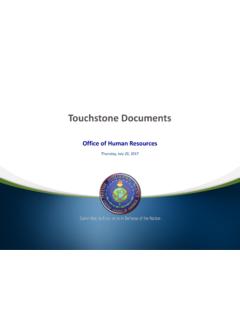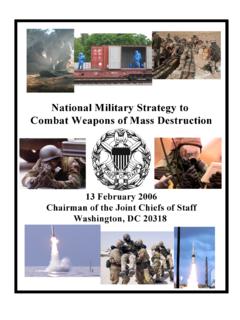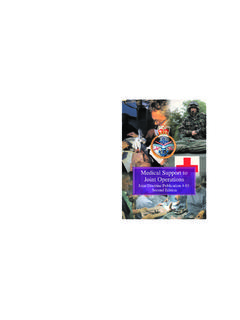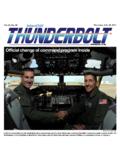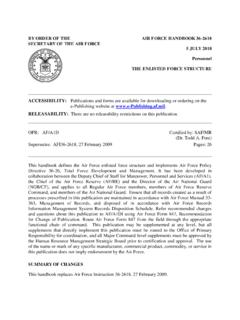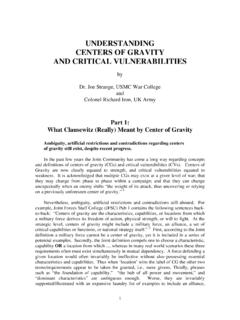Transcription of ANNUAL THREAT ASSESSMENT - Defense …
1 ANNUAL THREAT ASSESSMENT Statement Before the Senate Armed Services Committee United States Senate 11 February 2014 Michael T. Flynn, Lieutenant General, Army Director, Defense Intelligence Agency Good morning, Chairman Levin, Ranking Member Inhofe, and members of the committee. Thank you for this opportunity to testify and for your continued support to the dedicated men and women of the Defense Intelligence Agency (DIA), many of whom remain forward deployed directly supporting and allied military forces in Afghanistan and other places around the world.
2 DIA s mission is to prevent strategic surprise, deliver a decision advantage, and to deploy globally to meet any challenge. Our goal is to help the Nation understand the threats it faces, enable decisions and actions from the President of the United States to a private on the ground and help our country prepare for the threats we will face in the future. With our focus on foundational intelligence and focused intelligence collection and analysis that supports war fighters as well as policy makers, we bring a unique perspective to the Intelligence Community (IC).
3 The United States continues to face a complex security environment marked by a broad spectrum of dissimilar threats emerging from countries and highly adaptive transnational terrorist networks. DIA is focused on immediate and long term threats to allied forces in Afghanistan; risks posed by transnational terrorist organizations, especially as they relate to threats to military forces and facilities; the THREAT of weapons of mass destruction falling into the hands of non state actors and the proliferation of these weapons to state actors; monitoring the potential THREAT to the from ongoing conflicts; the emergence of foreign militaries with near peer capabilities.
4 And support for US and Allied forces, at sea or on the ground, deployed around the world. Defense intelligence must be able to provide timely and actionable intelligence across the entire THREAT spectrum. Our assessments are based upon the agency s worldwide human intelligence, technical intelligence, counterintelligence, and document and media exploitation capabilities, along with information from DIA s partners in the IC and the entire Defense intelligence enterprise, international allies, and open sources. In cooperation with these partners and allies, DIA is strengthening its collection and analysis as well as sharing more information across intelligence disciplines, and with our nation s close allies, to better understand the multitude of the threats facing the nation.
5 The men and women of DIA know they have a unique responsibility to the American people and take great pride in their work. I am privileged to serve with them and present their analysis to you. On behalf of the entire Defense intelligence enterprise, thank you for your continuing confidence. Your support is vital to us. I will begin my testimony first with an ASSESSMENT of Afghanistan, where the Department of Defense (DoD), the IC, DIA, and our coalition partners remain actively engaged supporting military operations against the THREAT of al Qa ida and other anti government of Afghanistan forces, transition to global threats , and conclude with an overview of other regional challenges.
6 AFGHANISTAN As the International Security Assistance Force (ISAF) continues the transition in Afghanistan, the Afghan government and the Afghan National Security Forces (ANSF) will seek to conduct presidential and provincial council elections in 2014 and maintain security following the ANSF s assumption of full security responsibilities lead for all of Afghanistan in 2013. Afghan Security Forces have shown progress in their ability to clear insurgents from contested areas, but have exhibited problems holding cleared areas long term. As an auxiliary to Afghanistan s formal security forces, the Afghan Local Police (ALP) continued to support broader efforts by securing some rural areas that might otherwise lack a central government presence.
7 Operationally, Afghan forces have adapted to the reduction of ISAF enabler support by making better use of their own capabilities and showing tactical competence in planning and conducting security operations. However, they struggle due to the lack of intelligence, surveillance and reconnaissance, (ISR) capability, as well as expertise in, and technology for countering counter improvised explosive device (IED) programs. This challenge, along with stretched ANSF airlift and logistical capacity, limits the Afghan National Army s (ANA) ability to sustain operations outside of large urban areas and logistical hubs.
8 They have been unable to deny freedom of movement to the insurgency in rural areas. Uncertainty over the post 2014 security environment presence, funding, government cohesion and Taliban strength is likely to drive decisions at all levels over the next year as ANSF leaders are forced to prioritize objectives, while hedging against this uncertainty. Influential power brokers and regional security officials are increasingly concerned with strengthening their influence over ANSF units and ensuring security across their respective areas of authority. These competing priorities could result in politically driven missions that undermine the ANSF s ability to address militarily necessary requirements.
9 The Afghan National Army (ANA) and Afghan National Police (ANP) manning of approximately 340,000 personnel remained short of the funded ceiling of 352,000. High attrition, low recruitment, and inconsistent pay reduce the ANA s on hand strength and remain an impediment to the ANA s resilience. The number of insider attacks from within the Afghan security forces against ISAF personnel significantly decreased in 2013 (13 incidents compared to 48 in 2012). This change is likely a result of a reduced ISAF presence and improved mitigation efforts by both ISAF and the ANSF.
10 The number of insider attacks against Afghan security force personnel increased to 76 incidents, compared to 50 in 2012. Approximately half of all attacks involved ANP as perpetrators, and the ALP accounted for the second largest share. Afghanistan s political stability depends on successful elections in 2014 and the subsequent transfer of power from President Hamid Karzai to his successor. Afghan preparations for the April 5th presidential and provincial council elections are on track. The lack of a consensus candidate could lead to a potentially destabilizing runoff election that would occur during the peak of the insurgent fighting season and ISAF s drawdown.




